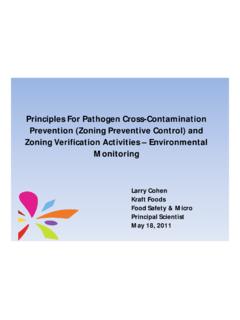Transcription of Determining the Thermal Resistance of Microorganisms in ...
1 Determining the Thermal Resistance of Microorganisms in Low Moisture Foods Carrie Ferstl, Manager, Research Microbiology April 4, 2012. Presentation Overview Food Safety and Low Moisture Foods Behavior of Microorganisms in Low Moisture Foods Thermal Process Validations A Microbiologist's Perspective Phase I: Process/Product Review Phase II: Microbial Kinetics Studies Phase III: In-Process Validation Questions Confidential 2. Food Safety and Low Moisture Foods Dehydration as a preservation method Inhibits microbial growth Extension of shelf life Does this apply to Food Safety? Confidential 3. Food Safety and Low Moisture Foods Outbreaks Organism Product Year E. coli O157:H7 Salami 1994. E. coli O111:NM Semidry Sausage 1995. E. coli O157:H7 Venison Jerky 1995. Salmonella Saint-Paul, Javiana, Rubislaw Paprika Chips 1993. Salmonella Senftenberg Infant Cereals 1995.
2 Salmonella Mbandaka Peanut Butter 1996. Salmonella Agona Toasted Oat Cereal 1998. Salmonella spp. Dried Squid 1999. Salmonella Oranienburg, Chester Cuttlefish Chips 1999. Salmonella Stanley, Newport Peanuts 2001. Salmonella Oranienburg Chocolate 2001. Salmonella Enteritidis Raw Almonds 2003-2004. Salmonella Montevideo Chocolate 2006. Salmonella Tennessee Peanut Butter 2006-2007. Salmonella Agona Puffed Cereals 2008. Salmonella Give Powdered Infant Formula 2008. Salmonella Typhimurium Peanut Butter, Peanut Butter Containing Products 2008-2009. Confidential 4. Behavior of Microorganisms in Low Moisture Foods Low water activity limits growth of Microorganisms Pathogens can survive in this environment Pathogens demonstrate higher Thermal Resistance in low water activity environments Fat/oil, solids, and other intrinsic properties of a food product can protect/shield Microorganisms from Thermal treatment Pathogens with low infective dose can survive Thermal processing kill steps to cause infection Confidential 5.
3 Behavior of Microorganisms in Low Moisture Foods Knowledge of Thermal Resistance of bacteria can help to determine proper Thermal treatment parameters for a given food product Confidential 6. Food Safety Goals Understanding the food safety risks associated with your product Understanding how the composition of your product influences bacterial behavior Understanding how a process implemented as a kill step influences the survival of bacteria in the product How is this done? Confidential 7. Thermal Process Validations Confidential Thermal Process Validation Roadmap Phase I: Process/. Product Review Phase III: In- Process Validation Phase II: Microbial Final Result: Kinetics (TDT). Determination of the level of reduction of the target organism delivered by the Thermal process Confidential 9. Food Safety Vocabulary Target Organism Pathogenic organism(s) of significance in a given food product.
4 Surrogate Organism Non-pathogenic organism which mimics process Resistance of target organism and is suitable for use in validation work. Kill-Step Process step which results in sufficient destruction of the target organism. Kill-Ratio Mathematical correlation between the destruction of surrogate and target organisms. Process Lethality Measure of process' ability to destroy the target organism, normally expressed as log reduction for the target organism. Confidential 10. Food Safety Vocabulary D value The time required at a constant temperature to destroy 90% of the Microorganisms present. It can be determined experimentally by conducting TDT studies for a given organism in a specific product. Confidential 11. Food Safety Vocabulary z value The change in temperature necessary to bring about a 10-fold (1-log) change in the D. value. It can be determined experimentally by conducting TDT studies for a given organism in a specific product Confidential 12.
5 Phase I: Process/Product Review Confidential Process/Product Review Understand the process: Equipment being validated Manner of heat application Temperature and time (equipment settings and actual of product). Understand the product: Intrinsic properties (pH, aw, moisture, fat/oil, solids). Physical properties (piece size, shape, surface structure, surface area). Confidential 14. Process/Product Review Review the scientific literature to: Understand the impact of process and product properties on bacterial survival Help to select the worst case scenario for subsequent work Help to select appropriate strains for validation work Confidential 15. Process/Product Review Example: Zone Zone Zone Product 1 2 3 Product Entering Exiting Dryer Dryer 160-170 F; 180-190 F; 170-180 F;. 30 min 60 min 60 min aw = Note: Heat Resistance of Salmonella aw = is greater at lower water activities.
6 Confidential 16. Phase II: Microbial Kinetics Studies TDT's and D and z values Confidential Phase II: Microbial Kinetics (TDT). What is a Thermal Death Time (TDT). Study? Study designed to determine the Thermal Resistance of a specific bacteria in a defined product Confidential 18. Phase II: Microbial Kinetics (TDT). Defined Product Primarily based on most conservative aw Consideration also for other intrinsic and physical factors Target Organisms Appropriate for product Salmonella, Escherichia coli O157:H7. Surrogate Organism Enterococcus faecium (NRRL B-2354) is a common surrogate used for Salmonella for the evaluation of Thermal processes applied to low moisture foods For a Thermal process, surrogate must demonstrate similar or greater Resistance compared to the target organism before it can be used Confidential 19. Phase II: Microbial Kinetics (TDT).
7 Surrogate Microorganisms for Salmonella spp.: Organism Food Reference B. stearothermophilus spores, Animal feed, Okelo et al, 2006. B. stearothermophilus 12980 Poultry feed Okelo et al, 2008. Enterococcus faecium Almonds ABC, 2007b NRRL B-2354*. Pantoea agglomerans Dry roast almonds ABC, 2007d SPS2F1. Pediococcus spp. and Ground, formed beef Pediococcus acidilactici Borowski et al, 2009. jerky Saga 200 and Biosource . Whole-muscle Pediococcus spp. Williams et al, 2010. turkey jerky Never use pathogens in a food process environment. Confidential 20. Phase II: Microbial Kinetics (TDT). TDT Protocol Development Process: Preparation of organism(s). Growth conditions can impact Thermal Resistance Inoculation method for selected product Prevent changing intrinsic product parameters (pH, aw, etc.). Use of sand, chalk, spray (atomizer), freeze-dried culture Heat treatment method Water bath, Oil bath, Oven Recovery / enumeration method for target and surrogate organisms Confidential 21.
8 Phase II: Microbial Kinetics (TDT). Conduct Thermal death time (TDT) studies on target and surrogate organisms in selected worst case product Preliminary studies to determine the appropriate heat application method, packaging, temperature monitoring of product during Thermal treatment Screening studies to determine the appropriate temperature range, time Final TDT study: 5-6 time intervals, 5 temperatures, triplicate samples Confidential 22. Phase II: Microbial Kinetics (TDT). Example Survival Graph: Results from One TDT Study 165 F. 170 F. Survival Log CFU/g 175 F. 180 F. 190 F. y = + R2 = y = + R2 = y = + y = + y = + R2 = R2 = R2 = 0 10 20 30 40 50 60 70 80 90. Treatm ent tim e (m in). This is an example graph and is for illustration only. Confidential 23. Phase II: Microbial Kinetics (TDT). Generate D and z values for target and surrogate organisms in the product Determine correlation ( kill-ratio ) between target and surrogate organisms at selected time/temp Log reduction should be 1:1 for target:surrogate Estimate the theoretical log reduction of target organisms in the product during the process based upon Thermal process data (time/temperature).
9 Confidential 24. Phase II: Microbial Kinetics (TDT). Benefits of Determining D and z values Allows for assessment of effectiveness of process as a kill step for target organisms Allows for accurate quantification of kill ratio . between surrogate and target organisms D and z values will allow for process adjustments to optimize the process, if needed D and z values will allow you to address process deviations Confidential 25. Phase II: Microbial Kinetics (TDT). Risk of Not Completing Kinetics Studies Prior to On-Site Validation Work Surrogate may not be appropriate for target organisms Confidential 26. Phase II: Microbial Kinetics (TDT). Salmonella y = + Surrogate R2 = Surrogate IS NOT. 1 appropriate for Log D-value Salmonella y = + 2. R = Surrogate IS. appropriate for Salmonella 0. 155 160 165 170 175 180 185 190. Treatment Temp. ( F). Confidential 27.
10 Phase III: In-Process Validation Confidential Phase III: In-Process Validation Temperature distribution testing in the product on the process line (finding the cold spot). A B. Thermal image of chicken patties during processing (A), and actual appearance of chicken patties during processing (B). Thermal imagery example from the website: Confidential 29. Phase III: In-Process Validation Preparation of inoculated products with surrogate organism (w/o changing intrinsic properties). On-site process validation using inoculated product Inoculated product is subjected to the process Insertion and recovery of inoculated samples from process is critical Lab analysis of on-site validation samples Confidential 30. Phase III: In-Process Validation Final Result: Determination of the log reduction of surrogate during the production process Calculation of log reduction of the target organism, based upon the kill ratio between the target and surrogate organisms This will be compared to the calculated kill using D and z values Confidential 31.






